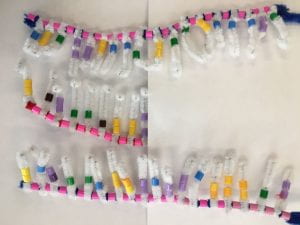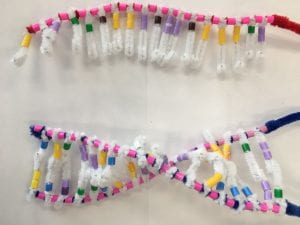How is mRNA different than DNA?
mRNA is a molecule that copies information from a gene on DNA, so instead of having it’s own sequence of bases, it copies the sequence of bases from a DNA gene to build the protein. While DNA is responsible for storing and transferring genetic information, mRNA is just a messenger between DNA and ribosomes to make proteins.
Describe the process of transcription



Transcription is the process of how the information of DNA is copied onto an mRNA strand. They use the same three steps as DNA replication: Unwinding/Unzipping, Complimentary Base Pairing and Separation. In the unwinding/unzipping stage, the DNA molecule unwinds from it’s double helix shape and the H bonds holding the bases together breaks, having an unzipping effect. In the complimentary base pairing stage, the bases of the sense DNA strand (the strand that has the correct instructions for building the protein) join together with the mRNA strand by the enzyme RNA polymerase represented by purple playdough. In separation, the mRNA strand will separate from the DNA strand and the DNA strand will join back with its other strand, the nonsense strand, forming back into its double helix shape. The mRNA is now ready to leave the nucleus, heading to the cytoplasm.
How did today’s activity do a good job of modelling the process of RNA transcription? In what ways was our model inaccurate?
It did a good job of showing the different bases distinctively because of the different coloured beads. The model showed how the process of transcription occurs really well so it was easy to follow. Everything in the model is colour coded so it is easy to identify everything.
Describe the process of initiation, elongation and termination





In initiation, the smaller ribosomal subunit binds to mRNA and then the smaller subunit binds to the larger ribosomal subunit. In elongation, the ribosome holds onto the mRNA strand and allows tRNA to to bind to the appropriate sites. The tRNA reads the codon and creates an anti codon which is specific to an amino acid. The amino acid on one tRNA (P site) binds to the neighbouring tRNA creating a chain of amino acids. The tRNA on the P site leaves the ribosome, and the ribosome moves down the mRNA codon continuing making the protein. In termination, a STOP codon is read and the creation of the protein stops. The mRNA dissociates into two and the protein is released.
How did today’s activity do a good job of modelling the process of translation? In what ways was our model inaccurate?
The model did a good job at showing the process of translation by also showing each step clearly. Although, my group found it a little confusing after asking other groups it made more sense and it was easier to follow. Once we understood how to do it, it was a great tool in understanding the process of translation. It was inaccurate because the model showed the ribosome as one unit instead of two subunits and how can occur at multiple places on the mRNA strand.